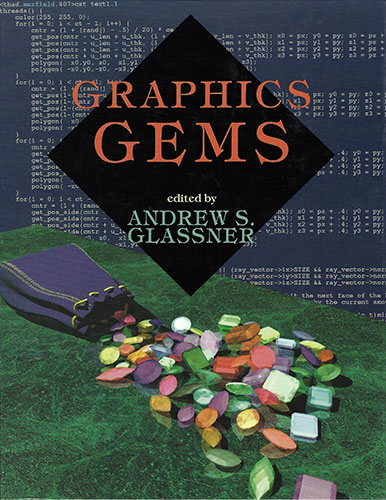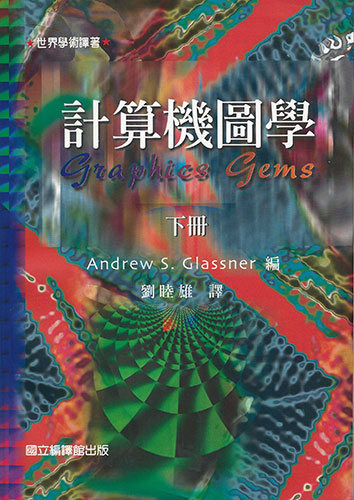Graphics Gems

 The Graphics Gems series was an unexpected phenomenon in my life: a wallet-sized card that turned into a series of five books.
The Graphics Gems series was an unexpected phenomenon in my life: a wallet-sized card that turned into a series of five books.
It started in the Spring of 1989, when publisher Alice Peters visited Xerox PARC. We met in my office and instantly hit it off, sharing ideas for projects. I remembered a few years earlier someone had showed me a little card that fit in his wallet but contained all the principal physical constants and equations that he worked with on a daily basis. I thought it would be fun to make a similar, wallet-sized card for computer graphics. As we discussed the idea, it became clear that we’d need more space. Thus I suggested “a little book” that you could fit in your back pocket, perhaps a dozen pages long. Alice was all for the idea and encouraged me to write it. She and I discussed what our fallback plan should be in case the book was literally too small to be economical to publish! We were so innocent, so naive…
As I put together an outline for this little book, I thought maybe other people had their own little bits of knowledge that should be included. I asked Alice if she’d be okay if our “little book” became a “small book,” and she was again fine with that. I still thought it would be about 30 pages at the most.
I made a little one-page handout asking people for contributions, made a ton of copies (one of the benefits of working for Xerox!), and took them to the SIGGRAPH 89 conference in Boston. I put piles of flyers at the bases of elevators, near the front doors of lecture halls, and generally all over the place. I thought I might get 25 or even 30 submissions.
By January, I had over 110 fantastic submissions, with more arriving every day.
With Alice’s invaluable support and help, this little book became a real book containing an enormous wealth of practical information by and for people working in computer graphics. I organized the articles into chapters and edited them to have a roughly consistent style. I drew graphics for the opening of every chapter. In an unusual move at the time, I worked with the authors to provide a ton of open-source code that implemented their ideas. And rather than pay each contributor a flat fee for their piece, I gave everyone a slice of the royalty pie, so every author made some money from every book.
Thus was born Graphics Gems. When the book came out I was happy and proud of it, but then I got two surprises. First, the book was a much bigger hit than anyone had expected. It was even translated into Chinese! Second, people continued to send in new contributions for the “next volume”. It seemed clear that our book filled a niche and that there was plenty of great material for another volume, and thus the Graphics Gems Series was launched.
New and used copies of Graphics Gems are available online, for example from Amazon. You can download all of the Gems code from all five 5 books, including bug fixes, from the terrific Graphics Gems Code Repository, a site run by Eric Haines.
The cover of Graphics Gems was designed and rendered by Thad Beier, then of PDI. The upper half of the cover displays some of the source code that generated the lower half!
